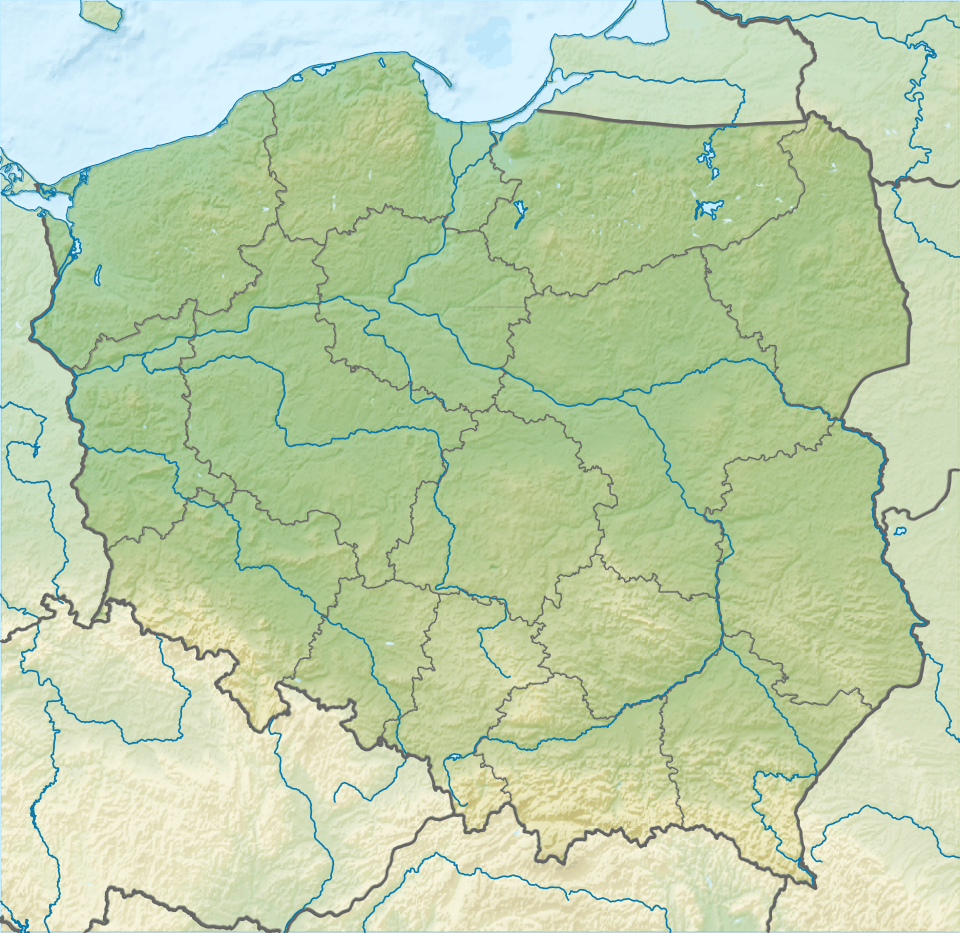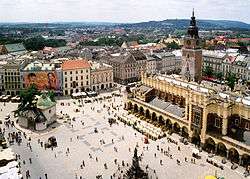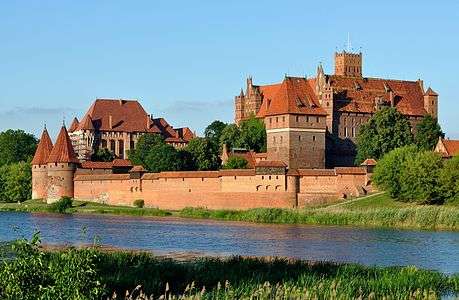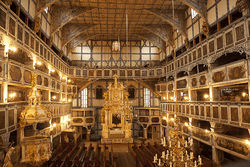List of World Heritage Sites of Poland

A UNESCO World Heritage Site is a place that is listed as site of outstanding cultural or natural importance to the common heritage of humanity.[1] There are fourteen World Heritage Sites in Poland (1[note 1] Natural and 13[note 2][note 3] Cultural). The first two sites were inscribed on the World Heritage List in 1978. Three of the sites, Belovezhskaya Pushcha / Białowieża Forest, Wooden Tserkvas of Carpathian Region in Poland and Ukraine and Muskauer Park / Park Mużakowski are shared with neighboring countries (Belarus, Ukraine and Germany respectively). Poland also has four sites on the Tentative List.
Significance
The entire medieval Kraków Old Town was among the first sites chosen for the WHS list. In 2013 the Bochnia Salt Mine was added to the WHS List as an extension of the Wieliczka Salt Mine inscription of 1978. Warsaw's Old Town was placed on the WHS list as "an outstanding example of a near-total reconstruction of a span of history covering the 13th to the 20th century.
World Heritage Sites
| Name | Image | Location | Date | UNESCO data | Description |
|---|---|---|---|---|---|
| Historic Centre of Kraków |  |
Kraków 50°04′01″N 19°57′36″E / 50.067°N 19.96°E |
11th–19th century | 29; 1978; iv |
Kraków Old Town is the historic central district of Kraków, Poland.[2] It is one of the most famous old districts in Poland today and was the center of Poland's political life from 1038 until King Sigismund III Vasa relocated his court to Warsaw in 1596. The entire medieval old town is among the first sites chosen for the UNESCO's World Heritage List, inscribed as Cracow's Historic Centre.[3][4] |
| Wieliczka and Bochnia Royal Salt Mines |  |
Wieliczka 49°58′45″N 20°03′50″E / 49.979167°N 20.063889°E |
13th-20th century | 32; 1978; iv |
The Wieliczka Salt Mine, located in the town of Wieliczka in southern Poland, lies within the Kraków metropolitan area. The mine continuously produced table salt from the 13th century until 2007 as one of the world's oldest operating salt mines, for most of this time span being a part of the undertaking żupy krakowskie. It is believed to be the world's 14th-oldest company. |
| Auschwitz Birkenau, German Nazi Concentration and Extermination Camp (1940–1945)[5] |  |
Oświęcim 50°02′09″N 19°10′42″E / 50.035833°N 19.178333°E |
1940-1945 | 31; 1979; vi |
Auschwitz was a network of Nazi concentration and extermination camps built and operated by the Third Reich in Polish areas annexed by Nazi Germany during World War II. It was the largest of the German concentration camps, consisting of Auschwitz I (the Stammlager or base camp); Auschwitz II–Birkenau (the Vernichtungslager or extermination camp); Auschwitz III–Monowitz, also known as Buna–Monowitz (a labor camp); and 45 satellite camps.[6] |
| Białowieza Forest |  |
Belarus and Poland 52°40′00″N 23°50′00″E / 52.666667°N 23.833333°E |
N/A | 33; 1979; vii |
The Białowieża Forest is an ancient woodland straddling the border between the two countries, located 70 km (43 mi) north of Brest (Belarus) and 62 km (39 mi) south-east of Białystok (Poland). It is one of the last and largest remaining parts of the immense primeval forest which once spread across the European Plain. The first recorded piece of legislation on the protection of the forest dates to 1538, when a document issued by King Sigismund I the Old instituted the death penalty for poaching a wisent (European bison). |
| Historic Centre of Warsaw |  |
Warsaw 52°14′59″N 21°00′44″E / 52.2498°N 21.0122°E |
13th–20th century | 30; 1980; ii, vi |
Warsaw's Old Town was established in the 13th century. Initially surrounded by an earthwork rampart, prior to 1339 it was fortified with brick city walls. The town originally grew up around the castle of the Dukes of Mazovia that later became the Royal Castle. The Market Square (Rynek Starego Miasta) was laid out sometime in the late 13th or early 14th century, along the main road linking the castle with the New Town to the north. |
| Old City of Zamość | |
Zamość 50°43′14″N 23°15′31″E / 50.720556°N 23.258611°E |
1582–17th century | 564; 1992; iv |
Jan Zamoyski commissioned the Italian architect Bernardo Morando to design the city that would be based on the anthropomorphic concept. The main distinguishing features of the Old Town have been well preserved since its establishment. It includes the regular Great Market Square of 100 x 100 meters with the splendid Townhall and so-called Armenian houses, as well as the fragments of the original fortress and fortifications, including those from the period of the Russian occupation in the 19th century.[7] |
| Castle of the Teutonic Order in Malbork |  |
Malbork 54°02′23″N 19°01′40″E / 54.039722°N 19.027778°E |
13th-14th century | 847; 1997; ii, iii, iv |
The Castle in Malbork is the largest castle in the world by area.[8] It was built in Prussia by the Teutonic Knights, a German Roman Catholic religious order of crusaders, in a form of an Ordensburg fortress. The Order named it Marienburg (Mary's Castle). The town which grew around it was also named Marienburg. The castle is a classic example of a medieval fortress, and on its completion in 1406 was the world's largest brick Gothic castle. |
| Medieval Town of Toruń |  |
Toruń 53°02′00″N 18°37′00″E / 53.033333°N 18.616667°E |
12th–15th century | 835; 1997; ii, iv |
Toruń has many monuments of architecture beginning from the Middle Ages, including 200 military structures. The city is famous for having preserved almost intact its medieval spatial layout and many Gothic buildings, all built from brick, including monumental churches, the Town Hall and many burgher houses. In 1236, due to frequent flooding,[9] the city was relocated to the present site of the Old Town. In 1264 the nearby New Town was founded. In 1280, the city (or as it was then, both cities) joined the mercantile Hanseatic League, and thus became an important medieval trade centre. |
| Kalwaria Zebrzydowska: the Mannerist Architectural and Park Landscape Complex and Pilgrimage Park |  |
Kalwaria Zebrzydowska 49°51′37″N 19°40′15″E / 49.860319°N 19.670719°E |
1605-1632 | 905; 1999; ii, iv |
The town is named after the religious complex (calvary) founded by Governor of Kraków Mikołaj Zebrzydowski on December 1, 1602. The complex is known as the Kalwaria Zebrzydowska park. The city of Zebrzydów was established in 1617 in order to house the growing number of pilgrims visiting the religious complex. |
| Churches of Peace in Jawor and Swidnica |  |
Jawor, Świdnica 51°03′14″N 16°11′46″E / 51.054°N 16.196°E |
1654-1657 | 1054; 2001; iii, iv, vi |
The Churches of Peace in Jawor and Świdnica in Silesia were named after the Peace of Westphalia of 1648 which permitted the Lutherans in the Roman Catholic parts of Silesia to build three Evangelical churches from wood, loam and straw outside the city walls, without steeples and church bells. The construction time was limited to one year. |
| Wooden Churches of Southern Lesser Poland | .jpg) |
Lesser Poland Voivodeship 49°51′34″N 20°16′29″E / 49.859444°N 20.274722°E |
15th-18th century | 1053; 2003; iii, iv |
The wooden church style of the region originated in the late Medieval, the late sixteenth century, and began with Gothic ornament and polychrome detail, but because they were timber construction, the structure, general form, and feeling is entirely different from the gothic architecture or Polish Gothic (in stone or brick). |
| Muskauer Park / Park Mużakowski |  |
Germany and Poland 51°33′01″N 14°43′36″E / 51.550278°N 14.726667°E |
1815-1844 | 1127; 2004; i, iv |
The Muskau Park is the largest and one of the most famous English gardens of Germany and Poland. Situated in the historic Upper Lusatia region, it covers 3.5 square kilometers (1.4 sq mi) of land in Poland and 2.1 km2 (0.81 sq mi) in Germany. UNESCO added the park to its World Heritage List, as an exemplary example of cross-border cultural collaboration between Poland and Germany. |
| Centennial Hall |  |
Wrocław 51°06′26″N 17°04′37″E / 51.107222°N 17.076944°E |
1911-1913 | 1165; 2006; i, ii, iv |
The Centennial Hall (formerly People's Hall) is a historic building in Wrocław. It was constructed according to the plans of architect Max Berg in 1911–1913, when the city was part of the German Empire. As an early landmark of reinforced concrete architecture, it was listed as a UNESCO World Heritage Site. |
| Wooden Tserkvas of Carpathian Region in Poland and Ukraine |  |
(Brunary, Chotyniec, Kwiatoń, Owczary, Powroźnik, Radruż Smolnik, Turzańsk) Poland and Ukraine | 16th - 19th century | 1424; 2013; iii, iv |
Situated in the eastern fringe of Central Europe, the transnational property numbers a selection of 16 tserkvas, churches, built of horizontal wooden logs between the 16th and 19th centuries by communities of the Eastern Orthodox and Greek Catholic faiths. They represent the cultural expression of four ethnographic groups and the formal, decorative and technical characteristics they developed over time. The tserkvas bear testimony to a distinct building tradition rooted in Orthodox ecclesiastic design interwoven with elements of local tradition, and symbolic references to their communities’ cosmogony. The tserkvas are built on a tri-partite plan surmounted by open quadrilateral or octagonal domes and cupolas. They feature wooden bell towers, iconostasis screens, and interior polychrome decorations as well as churchyards, gatehouses and graveyards. |
Tentative List
- Gdansk—Town of Memory and Freedom (2005)
- The Augustów Canal (2006)
- The Dunajec River Gorge in the Pieniny Mountains (2006)
- Historic Silver Mine in Tarnowskie Góry and its Underground Water Management System (2013)
- Extension to the Joint World Heritage Property “Primeval Beech forests of the Carpathians (Slovak Republic and Ukraine) and the Ancient Beech forests of Germany (Germany)” (2015)
See also
Notes
- ↑ The natural site Belovezhskaya Pushcha / Białowieża Forest is shared between Belarus and Poland.
- ↑ The cultural site Muskauer Park / Park Mużakowski is shared between Germany and Poland.
- ↑ The cultural site "Wooden Tserkvas of Carpathian Region in Poland and Ukraine" is shared between Poland and Ukraine
References
- ↑ "World Heritage".
- ↑ Ingrid Gustafson, Let's Go: Eastern Europe Published by Macmillan, page 444. Let's Go Publications, 2008.
- ↑ Properties inscribed on the World Heritage list, Poland. UNESCO World Heritage Centre. Last updated: 3 September 2010
- ↑ 2nd session of the Committee UNESCO World Heritage Committee. Washington, D.C. 5–8 September 1978.
- ↑ UNESCO World Heritage Committee. (2007-06-28). World Heritage Committee approves Auschwitz name change". Press release. The World Heritage Committee has approved Poland's request to change the name of Auschwitz on UNESCO's World Heritage List. After international consultations, the property, listed as "Auschwitz Concentration Camp" in 1979, is to have the title of "Auschwitz Birkenau" and the subtitle of "German Nazi Concentration and Extermination Camp (1940–1945)".
- ↑ (English) Shmuel Krakowski (1994). The Satellite Camps. Gutman and Berenbaum. p. 50.
- ↑ A. Kędziora: Encyklopedia miasta Zamościa. Chełm: Towarzystwo Opieki nad Zabytkami, 2000
- ↑ Malbork Castle (with an area of 143,591 square meters), the largest castle in the world by KML Area Calculator. Touropia, the Travel List Website: "10 Largest Castles in the World." Accessed 6 April 2011.
- ↑ Max Töppen Historisch-comparative Geographie von Preussen: Nach den Quellen, namentlich auch archivalischen, J. Perthes, 1858; PDF
External links
| Wikimedia Commons has media related to World Heritage Sites in Poland. |
- Poland at the UNESCO World Heritage Centre
- (Polish) Polish UNESCO Committee
- Things to do and see in Warsaw

